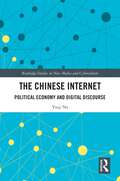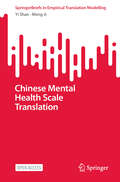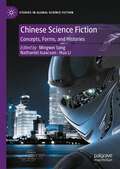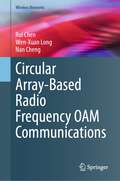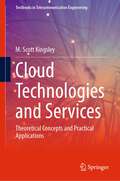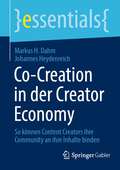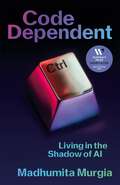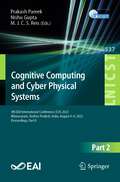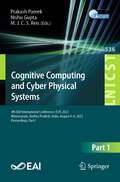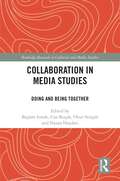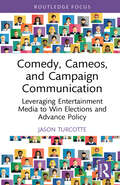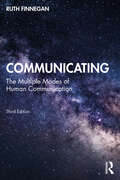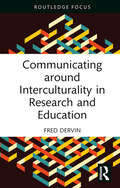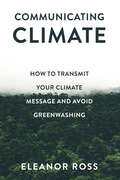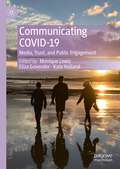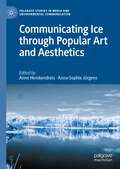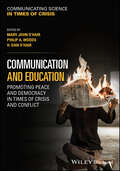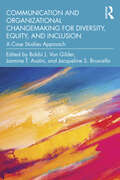- Table View
- List View
The Chinese Internet: Political Economy and Digital Discourse (Routledge Studies in New Media and Cyberculture)
by Yuqi NaThis book explores China’s digital discourse and how the Internet influences social and ideological changes to the country’s political economy, within China’s historical context and through a variety of social and political actors. Analysing discourses as diverse as policy papers, addresses from the Xi-Li Administration, speeches from CEOs of the dominant Internet companies in China, as well as those of Chinese citizens, the book illuminates the dynamics, complexity, and structural contradictions in China’s current network technology-enabled developmental path through the lens of ideology and discourse. The book proposes a multi-dimensional model to understand Marxist ideologies under capitalism, emphasising the relevance of alienation, commodity fetishism, and reification in contemporary discussions of ideology and discourse. This insightful study offers fresh insights into Chinese digital discourse and will be of interest to upper-level students and scholars of communication studies, digital media, sociology, political science, and internet and technology studies.
Chinese Mental Health Scale Translation (New Frontiers in Translation Studies)
by Meng Ji Yi ShanThis open access book illustrates the key steps and procedures of developing mental health scales into linguistically and culturally appropriate translations. Through illustrative case studies, we demonstrate that traditional forward and backward translation have significant methodological limitations when applied in mental health scale translation, such as linguistic and cultural inaccessibility and inaccuracy in the clinic. Our book will stimulate more academic debates and further systematic research into the significant, interdisciplinary area of mental health translation, which has been underexplored in Translation Studies.
Chinese Science Fiction: Concepts, Forms, and Histories (Studies in Global Science Fiction)
by Mingwei Song Nathaniel Isaacson Hua LiThis volume brings together emerging approaches and addresses shifting paradigms in Chinese science fiction studies, offering a window on fan cultures, internet fiction, gender, eco-criticism, post-humanism and biomedical discourse. These studies present a “second wave” of Chinese sf studies, re-evaluating the canon of Chinese sf print and cinematic production, and expand the range of critical approaches to the subject. The structure of the volume is both chronological and theme-focused. These studies also demonstrate that Chinese science fiction represents a significant contribution to modern Chinese cultural production, both in terms of its value, speaking powerfully to our modern condition, and its sheer volume in terms of production and consumption. Chinese science fiction speaks to both China’s rapidly shifting reality, its political multiplicity and its formless future, voicing the anticipations and anxieties of a new epoch filled with accelerating alterations and increasing uncertainty.
Circular Array-Based Radio Frequency OAM Communications (Wireless Networks)
by Rui Chen Wen-Xuan Long Nan ChengThis book presents the modeling and transmission theory of RF OAM communications. The book features the UCA-based RF point-to-point OAM communication system, the UCA-based RF point-to-multipoint OAM wireless backhaul network, the HCCL structure for long-distance OAM transmissions, and the UCA-based joint OAM RadCom scheme. For the UCA-based RF point-to-point OAM communication system, a 2-D ESPRIT-based distance and AoA estimation method is first introduced, followed by an OAM reception scheme including the hybrid mechanical and electronic beam steering with the estimated AoA and the amplitude detection with the estimated distance. The proposed RF OAM communication scheme is extended to the RF OAM-MIMO system equipped with UCCAs. For the UCA-based RF point-to-multipoint OAM wireless backhaul network, an OAM-based multi-user distance and AoA estimation method is introduced, followed by a multi-user OAM preprocessing scheme. At last, the proposed methods are extended to the downlink multi-user OAM-MIMO wireless backhaul system equipped with UCCAs. Moreover, a novel HCCL structure is introduced to realize long-distance OAM transmission. For the UCA-based joint OAM RadCom scheme, an OAM-based 3-D super-resolution position estimation and rotation velocity detection method is introduced, and then the PCRB of the OAM-based estimates and the transmission rate of the integrated system are derived and analyzed. To achieve the best performance trade-off, the transmitted integrated OAM beams is optimized by means of an exhaustive search method. Finally, this book discusses future research directions to inspire further investigation in the field of RF OAM communications from different perspectives.
Cloud Technologies and Services: Theoretical Concepts and Practical Applications (Textbooks in Telecommunication Engineering)
by M. Scott KingsleyThis textbook provides a thorough yet compact review of cloud technologies. It offers easy to understand explanations of the technical concepts underlying cloud services, platforms, and applications offered by Amazon Web Services (AWS), Microsoft Azure, and the Google Cloud Platform (GCP). It presents cloud concepts at a depth that can be understood and applied by both technical and non-technical readers. Once that is accomplished the learner can then easily move toward more advanced topics. Or, they can use the knowledge gained from this book to obtain industry certifications and be competitive in this exciting industry. Reader learning is enhanced with quizzes and exam questions and hands-on labs throughout the book with PowerPoint slides, instructor guide and additional labs online. All the tools needed for advancement to the level of cloud architect are found in this book. The author has verified the success of this approach in his own academic environment with much success. He teaches Cloud Engineering and Advanced Cloud Engineering at Southern Methodist University. Both courses were developed in partnership with the AWS Academy, the education arm of the Amazon Web Services cloud platform. Using this methodology his students routinely take and pass cloud certification exams and obtain lucrative employment positions in the rapidly expanding cloud industry.
Co-Creation in der Creator Economy: So können Content Creators ihre Community an ihre Inhalte binden (essentials)
by Markus H. Dahm Johannes HeydenreichDieses essential wirft einen Blick auf die zunehmende Bedeutung von gemeinschaftlicher Kreation in der aufstrebenden Creator Economy und gibt Content-Erstellern wertvolle Einblicke und konkrete Ratschläge, wie sie durch die Zusammenarbeit mit Fans und Followern nicht nur die Arbeitslast teilen, sondern auch eine unterstützende Gemeinschaft aufbauen können. Das Buch analysiert erfolgreiche Co-Creation-Modelle, bei denen Content-Verfasser Inhalte gemeinsam entwickeln und dabei von gemeinsamen Vermarktungsstrategien und Monetarisierungsansätzen profitieren.
Code Dependent: Living in the Shadow of AI
by Madhumita MurgiaSHORTLISTED FOR THE WOMEN'S PRIZE FOR NON-FICTION 2024What does it mean to be human in a world that is rapidly changing with the development of artificial intelligence?'Highly readable and deeply important' – The Guardian'Exposes the hidden consequences of our existing AI technologies' – The TimesThrough the voices of ordinary people in places far removed from Silicon Valley, Code Dependent explores the impact of a set of powerful, flawed, and often exploitative technologies on individuals, communities, and our wider society. Madhumita Murgia, AI Editor at the FT, exposes how AI can strip away our collective and individual sense of agency – and shatter our illusion of free will.AI is already changing what it means to be human, in ways large and small. In this compelling work, Murgia reveals what could happen if we fail to reclaim our humanity.'The intimate investigation of AI that we’ve been waiting for, and it arrives not a moment too soon.' – Shoshana Zuboff, author of The Age of Surveillance Capitalism'A nuanced, thoughtful and very accessible picture of a world deeply affected by AI' – Martha Lane Fox
The Coffee-Table Book in the Post-War Anglophone World (New Directions in Book History)
by Christine ElliottThe Coffee-Table Book in the Post-War Anglophone World argues that coffee-table books appeared and became popular in the post-war era at the convergence of three important developments: advances in full colour printing technology, social change, and publishing entrepreneurism and innovation. Examining the coffee-table book through a book history lens acknowledges their significant contribution to post-war visual culture and illustrated publishing. Focussing on post-war America, Great Britain, and Australia during the “golden age” era of the 1950s, 1960s, and 1970s, this history of the coffee-table book takes an interdisciplinary approach to put the coffee-table book in context in regards to materiality, format, printing, status, and genre.
Cognitive Computing and Cyber Physical Systems: 4th EAI International Conference, IC4S 2023, Bhimavaram, Andhra Pradesh, India, August 4-6, 2023, Proceedings, Part II (Lecture Notes of the Institute for Computer Sciences, Social Informatics and Telecommunications Engineering #537)
by Prakash Pareek Nishu Gupta M. J. C. S. ReisThis 2-volume set constitutes the post-conference proceedings of the 4th International Conference on Cognitive Computing and Cyber Physical Systems, IC4S 2023, held in Bhimavaram, Andhra Pradesh, India, during August 4-6, 2023. The theme of IC4S 2023 was: cognitive approaches with machine learning and advanced communications. The 70 full papers were carefully reviewed and selected from 165 submissions. The papers are clustered in thematical issues as follows: machine learning and its applications; cyber security and signal processing; image processing; smart power systems; smart city eco-system and communications.
Cognitive Computing and Cyber Physical Systems: 4th EAI International Conference, IC4S 2023, Bhimavaram, Andhra Pradesh, India, August 4-6, 2023, Proceedings, Part I (Lecture Notes of the Institute for Computer Sciences, Social Informatics and Telecommunications Engineering #536)
by Prakash Pareek Nishu Gupta M. J. C. S. ReisThis 2-volume set constitutes the post-conference proceedings of the 4th EAI International Conference on Cognitive Computing and Cyber Physical Systems, IC4S 2023, Bhimavaram, Andhra Pradesh, India, during August 4-6, 2023. The theme of IC4S 2023 was: cognitive approaches with machine learning and advanced communications. The 70 full papers were carefully reviewed and selected from 165 submissions. The papers are clustered in thematical issues as follows: machine learning and its applications; cyber security and signal processing; image processing; smart power systems; smart city eco-system and communications.
Collaboration in Media Studies: Doing and Being Together (Routledge Research in Cultural and Media Studies)
by Begüm Irmak Can Koçak Onur Sesigür Nazan HaydariThis volume offers new perspectives on knowledge production through various forms of togetherness. Via diverse cases of collaboration in media studies, from methodological contemplations to on‑the‑field social practices, the book proposes reflections and inquiries around collective research, media, and action.The collection rethinks how scholarly endeavours feature different ways of doing and being together, identifying new and more diverse communicative spaces, challenging dichotomies, and encouraging critical perspectives. Scholars of a variety of disciplines recontextualise collaboration beyond the very nature of conventional academic approaches, to embrace vast connotations of media studies – from actions building connections across research and practice to transdisciplinary methodologies through analogue and digital realms.This book will be an invaluable resource for scholars and post‑graduate students from various fields of media studies, who carry an interest in collaborative and collective aspects of media as practice and research, as well as those in a variety of social science disciplines, participatory action research, media sociology, audience studies, intercultural communication, qualitative research methods, and participatory communication.
Collaboration in Media Studies: Doing and Being Together (Routledge Research in Cultural and Media Studies)
by Begüm Irmak Can Koçak Onur Sesigür Nazan HaydariThis volume offers new perspectives on knowledge production through various forms of togetherness. Via diverse cases of collaboration in media studies, from methodological contemplations to on‑the‑field social practices, the book proposes reflections and inquiries around collective research, media, and action.The collection rethinks how scholarly endeavours feature different ways of doing and being together, identifying new and more diverse communicative spaces, challenging dichotomies, and encouraging critical perspectives. Scholars of a variety of disciplines recontextualise collaboration beyond the very nature of conventional academic approaches, to embrace vast connotations of media studies – from actions building connections across research and practice to transdisciplinary methodologies through analogue and digital realms.This book will be an invaluable resource for scholars and post‑graduate students from various fields of media studies, who carry an interest in collaborative and collective aspects of media as practice and research, as well as those in a variety of social science disciplines, participatory action research, media sociology, audience studies, intercultural communication, qualitative research methods, and participatory communication.
Comedy, Cameos, and Campaign Communication: Leveraging Entertainment Media to Win Elections and Advance Policy (Routledge Studies in Media, Communication, and Politics)
by Jason TurcotteThis book provides a thorough foundation for understanding the shift from political campaigning via legacy news media to campaigning through entertainment media. Public discourse that would once transpire on the newsprint of opinion pages or behind a news anchor’s desk and teleprompter is now happening through talk shows and sitcoms, celebrity partnerships and influencer accounts, memes and streams, video games, branded merchandise, and social media. Here, Turcotte explores how media consumption habits have reshaped contemporary campaign norms and shifted strategies for seeking public office and advancing policy goals. He shows how candidates are incorporating entertainment media in their strategic campaigns, moving beyond satirical programs to demonstrate a multi-pronged approach to campaign communication in the entertainment environment. With a compelling introduction to these campaign shifts and an examination of tangible applications, this text is suitable for scholars as well as students in both political science and mass communication courses, particularly courses in political communication and strategic communication.
Comedy, Cameos, and Campaign Communication: Leveraging Entertainment Media to Win Elections and Advance Policy (Routledge Studies in Media, Communication, and Politics)
by Jason TurcotteThis book provides a thorough foundation for understanding the shift from political campaigning via legacy news media to campaigning through entertainment media. Public discourse that would once transpire on the newsprint of opinion pages or behind a news anchor’s desk and teleprompter is now happening through talk shows and sitcoms, celebrity partnerships and influencer accounts, memes and streams, video games, branded merchandise, and social media. Here, Turcotte explores how media consumption habits have reshaped contemporary campaign norms and shifted strategies for seeking public office and advancing policy goals. He shows how candidates are incorporating entertainment media in their strategic campaigns, moving beyond satirical programs to demonstrate a multi-pronged approach to campaign communication in the entertainment environment. With a compelling introduction to these campaign shifts and an examination of tangible applications, this text is suitable for scholars as well as students in both political science and mass communication courses, particularly courses in political communication and strategic communication.
Communicating: The Multiple Modes of Human Communication
by Ruth FinneganTreatments of human communication mostly draw on cognitive and word-centred models to present it as predominantly a matter of words. This, Finnegan argues, seriously underestimates the far-reaching multi-modal qualities of human interconnecting and the senses of touch, olfaction, and, above all, audition and vision that we draw on. In an authoritative and readable account, Ruth Finnegan brings together research from linguistic and sensory anthropology, material culture, non-verbal communication, computer-mediated communication, and, strikingly, research on animal communication, such as the remarkable gesture systems of great apes. She draws on her background in classical studies and her long anthropological experience to present illuminating examples from throughout the world, past and present. The result is to uncover an amazing array of sounds, sights, smells, gestures, looks, movements, touches, and material objects used by humans and other animals to interconnect both nearby and across space and time She goes on to first explore the extra-sensory modes of communication now being revealed in the extraordinary "new science" research and then, in an incendiary conclusion, to deny the long-prevailing story of human history by questioning whether orality really came before literacy; whether it was really through "the acquisition of language" that our prehistoric cave painting ancestors made a sudden leap into being "true humans"; and finally, astonishingly, to ask whether human communicating had its first roots not, after all, in verbal language but something else. Not to be missed, this highly original book brings a fresh perspective on, among other things, that central topic of interest today – the dawn of human history – and on what being homo sapiens really means. This revised and updated edition has additional illustrations, updated chapters, and a new concluding chapter. A provocative and controversial account that will stir worldwide debate, this book is an essential transdisciplinary overview for researchers and advanced students in language and communication, anthropology, and cultural studies.
Communicating: The Multiple Modes of Human Communication
by Ruth FinneganTreatments of human communication mostly draw on cognitive and word-centred models to present it as predominantly a matter of words. This, Finnegan argues, seriously underestimates the far-reaching multi-modal qualities of human interconnecting and the senses of touch, olfaction, and, above all, audition and vision that we draw on. In an authoritative and readable account, Ruth Finnegan brings together research from linguistic and sensory anthropology, material culture, non-verbal communication, computer-mediated communication, and, strikingly, research on animal communication, such as the remarkable gesture systems of great apes. She draws on her background in classical studies and her long anthropological experience to present illuminating examples from throughout the world, past and present. The result is to uncover an amazing array of sounds, sights, smells, gestures, looks, movements, touches, and material objects used by humans and other animals to interconnect both nearby and across space and time She goes on to first explore the extra-sensory modes of communication now being revealed in the extraordinary "new science" research and then, in an incendiary conclusion, to deny the long-prevailing story of human history by questioning whether orality really came before literacy; whether it was really through "the acquisition of language" that our prehistoric cave painting ancestors made a sudden leap into being "true humans"; and finally, astonishingly, to ask whether human communicating had its first roots not, after all, in verbal language but something else. Not to be missed, this highly original book brings a fresh perspective on, among other things, that central topic of interest today – the dawn of human history – and on what being homo sapiens really means. This revised and updated edition has additional illustrations, updated chapters, and a new concluding chapter. A provocative and controversial account that will stir worldwide debate, this book is an essential transdisciplinary overview for researchers and advanced students in language and communication, anthropology, and cultural studies.
Communicating around Interculturality in Research and Education (New Perspectives on Teaching Interculturality)
by Fred DervinThis book does not instruct the reader how to communicate interculturally but supports them in reflecting on how they can (re-)negotiate and (re-)construct knowledge(s), ideologies and relations around the notion of interculturality. Anchored in the author’s original and thought-provoking perspectives on interculturality, this interdisciplinary and global-minded book explores how communicating around the notion cannot do away with ideologisms, issues of language and translation or the problematization of voice and silence in research and education. Written in an original and stimulating way, relying on different writing genres and styles to ‘mimic’ the dynamism and flexibility of the very notion under review, the author urges us to (un-)voice, scrutinize, nurture and galvanize our ways of dealing with interculturality alone and together with others in academia. The very specific focus of the book, communicating around interculturality (instead of ‘doing’ interculturality), represents a fresh and important move for observing, analyzing, speaking of and contributing to today's complex and divided world. The title is aimed at researchers, students and educators interested in examining and enriching their own takes on interculturality, from a more reflexive and interactive perspective.
Communicating around Interculturality in Research and Education (New Perspectives on Teaching Interculturality)
by Fred DervinThis book does not instruct the reader how to communicate interculturally but supports them in reflecting on how they can (re-)negotiate and (re-)construct knowledge(s), ideologies and relations around the notion of interculturality. Anchored in the author’s original and thought-provoking perspectives on interculturality, this interdisciplinary and global-minded book explores how communicating around the notion cannot do away with ideologisms, issues of language and translation or the problematization of voice and silence in research and education. Written in an original and stimulating way, relying on different writing genres and styles to ‘mimic’ the dynamism and flexibility of the very notion under review, the author urges us to (un-)voice, scrutinize, nurture and galvanize our ways of dealing with interculturality alone and together with others in academia. The very specific focus of the book, communicating around interculturality (instead of ‘doing’ interculturality), represents a fresh and important move for observing, analyzing, speaking of and contributing to today's complex and divided world. The title is aimed at researchers, students and educators interested in examining and enriching their own takes on interculturality, from a more reflexive and interactive perspective.
Communicating Climate: How to Transmit Your Climate Message and Avoid Greenwashing
by Eleanor RossBusinesses can no longer afford to stick their heads in the sand. The time to act is now. Cities are becoming unliveable, triggering migration patterns and resource shortages, in turn causing civil wars and conflict. Natural disasters like hurricanes and wildfires are simply becoming known as ‘weather’, and biodiversity is disappearing from our very eyes. The fact is, we won’t have a planet to do business on if we don’t act now. Climate change is already hitting our bottom lines, as the cost of natural resources, energy, and manpower skyrocket. It’s predicted to cost the world $20 trillion a year if we can’t keep global heating to less than 2 degrees Celsius. This is a book about communicating climate: how to achieve cut-through, whether you’re trying to inspire your clients, get your shareholders on board, or simply showcase your progress in greening the world. This is not a greenwashing manual. It is about achieving balance in a world where we need to reduce our consumption, but also keep businesses functioning, just in a cleaner, greener, way. Communicating Climate is packed with case studies, examples, tips and interviews from those leading the charge towards sustainability.
Communicating Climate: How to Transmit Your Climate Message and Avoid Greenwashing
by Eleanor RossBusinesses can no longer afford to stick their heads in the sand. The time to act is now. Cities are becoming unliveable, triggering migration patterns and resource shortages, in turn causing civil wars and conflict. Natural disasters like hurricanes and wildfires are simply becoming known as ‘weather’, and biodiversity is disappearing from our very eyes. The fact is, we won’t have a planet to do business on if we don’t act now. Climate change is already hitting our bottom lines, as the cost of natural resources, energy, and manpower skyrocket. It’s predicted to cost the world $20 trillion a year if we can’t keep global heating to less than 2 degrees Celsius. This is a book about communicating climate: how to achieve cut-through, whether you’re trying to inspire your clients, get your shareholders on board, or simply showcase your progress in greening the world. This is not a greenwashing manual. It is about achieving balance in a world where we need to reduce our consumption, but also keep businesses functioning, just in a cleaner, greener, way. Communicating Climate is packed with case studies, examples, tips and interviews from those leading the charge towards sustainability.
Communicating COVID-19: Media, Trust, and Public Engagement
by Monique Lewis Eliza Govender Kate HollandThis edited collection, follows on from 'Communicating COVID-19: Interdisciplinary Perspectives' (2021) and brings together different scholars from around the world to explore and critique the ongoing advances of communicating COVID, two years into the pandemic. Pandemic life has become familiar to us, with all its disruptions and uncertainties. In the second year of COVID, many societies emerged well attuned to new waves of infections, while others, having initially demonstrated 'gold standard' responses, regressed, either through a premature end to public health restrictions or challenges around vaccine rollouts. In many countries, bitter social divisions have arisen over mask-wearing, lockdowns, quarantine and vaccination. To better understand the ever evolving communicative landscape of COVID-19, this collection shares updated perspectives from the disciplines of media and communication, journalism, public health and primary care, sociology, and political and behavioural science, addressing the major issues that have confronted communicators, including vaccine hesitancy, misinformation, and the mobilisation of community driven communication responses as restrictions eased in various parts of the world.
Communicating Ice through Popular Art and Aesthetics (Palgrave Studies in Media and Environmental Communication)
by Anne Hemkendreis Anna-Sophie JürgensThis book brings together the perspectives of eminent and emerging scholars from fields as varied as science communication, art history, pop cultural studies, environmental studies, sciences studying ice and artists to explore the power of (popular) arts and aesthetics to communicate ice research and the urgency of environmental action. Examining the aesthetic strategies employed in images, (popular) visual fiction and narratives to convey meaning and awareness – and how they can be made fruitful for science communication – the project will generate new perspectives on how our collective environmental responsibility can be addressed and communicated across disciplines and divers audiences. In doing so, the volume will illuminate the cultural power of ice research and contribute to a better understanding of the cultural work that emerges from our ecological crisis.
Communication and Education: Promoting Peace and Democracy in Times of Crisis and Conflict (Communicating Science in Times of Crisis)
by Mary John O'HairA timely and insightful exploration of the vital relationships among effective communication, education, peace, and democracy Communication and Education: Promoting Peace and Democracy in Times of Crisis and Conflict explores the complexities of addressing divisive societal challenges, reducing conflicts, and building and sustaining peace and democracy around the world. Contributions by an international panel of experts provide evidence-based practices, findings from ongoing research projects, policy analyses, and cutting-edge theories, frameworks, and models for confronting global challenges to peace and democracy. Examining the crucial role of crisis communication and education on a global scale, this research-based compendium covers a broad range of key topics, such as democratizing education, promoting peace through complexity science, understanding how factionalism threatens democracy, encouraging citizen participation, and more. Throughout the text, the authors highlight the need for equity, compassion, critical thinking, and active engagement to create a sustainable future based on democratic values. Designed to enhance the knowledge base of crisis communication related to crises impacting education, peace, and democracy, Communication and Education: Explores different strategies and practices for fostering democracy in education, such as the IDEALS framework for creating positive school cultures Discusses emotional geographies in schools and their impact on democratic school climate and teacher burnout Emphasizes empathic communication and participatory skills among teachers Offers practical strategies and examples of harnessing technology for peace and democracy Provides real-world case studies illustrating the transformative power of education, music, diverse perspectives, and open communication channels Examines the ecological interdependence of effective communication, education, democracy and peace Part of the Wiley Blackwell Communicating Science in Times of Crisis series, Communication and Education: Promoting Peace and Democracy in Times of Crisis and Conflict is essential reading for communication and education scholars, researchers, students, practitioners, and community scientists.
Communication and Education: Promoting Peace and Democracy in Times of Crisis and Conflict (Communicating Science in Times of Crisis)
by Mary John O᾿Hair Philip A. Woods H. Dan O᾿HairA timely and insightful exploration of the vital relationships among effective communication, education, peace, and democracy Communication and Education: Promoting Peace and Democracy in Times of Crisis and Conflict explores the complexities of addressing divisive societal challenges, reducing conflicts, and building and sustaining peace and democracy around the world. Contributions by an international panel of experts provide evidence-based practices, findings from ongoing research projects, policy analyses, and cutting-edge theories, frameworks, and models for confronting global challenges to peace and democracy. Examining the crucial role of crisis communication and education on a global scale, this research-based compendium covers a broad range of key topics, such as democratizing education, promoting peace through complexity science, understanding how factionalism threatens democracy, encouraging citizen participation, and more. Throughout the text, the authors highlight the need for equity, compassion, critical thinking, and active engagement to create a sustainable future based on democratic values. Designed to enhance the knowledge base of crisis communication related to crises impacting education, peace, and democracy, Communication and Education: Explores different strategies and practices for fostering democracy in education, such as the IDEALS framework for creating positive school cultures Discusses emotional geographies in schools and their impact on democratic school climate and teacher burnout Emphasizes empathic communication and participatory skills among teachers Offers practical strategies and examples of harnessing technology for peace and democracy Provides real-world case studies illustrating the transformative power of education, music, diverse perspectives, and open communication channels Examines the ecological interdependence of effective communication, education, democracy and peace Part of the Wiley Blackwell Communicating Science in Times of Crisis series, Communication and Education: Promoting Peace and Democracy in Times of Crisis and Conflict is essential reading for communication and education scholars, researchers, students, practitioners, and community scientists.
Communication and Organizational Changemaking for Diversity, Equity, and Inclusion: A Case Studies Approach
by Van Gilder, Bobbi J. Jasmine T. Austin Jacqueline S. BruscellaThis book explores the opportunities, challenges, and effective approaches to organizational change regarding diversity, equity, inclusion, and belonging. Featuring application-based case studies and practical guidelines for meaningful organizational change, this book problematizes some of the current DEI initiatives in today’s organizations. It examines multiple forms of diversity (e.g., race, age, and mental health) from a variety of perspectives (e.g., leadership and employee), with case studies that demonstrate how changemaking efforts can be reimagined and implemented in better, more nuanced, and more sustainable ways to produce meaningful organizational change. Through these case studies, readers learn from organizations’ successes and failures in their attempts to implement DEI practices. Each chapter concludes with explicit practical implications and/or actionable recommendations for organizational changemaking. This text will make an impactful addition to courses in communication and diversity or organizational communication/change at the advanced undergraduate or graduate level, and will be an essential guide for professionals wishing to lead change in their organizations.
